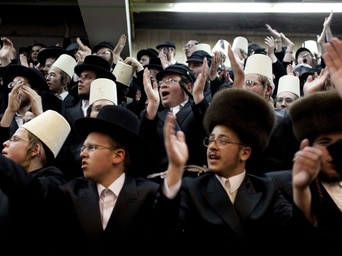DISCLOSURE: VT condemns the horrific tragedy committed by the NAZI Party against Jewish Citizens of Europe during Word War II known as the "Holocaust". VT condemns all racism, bigotry, hate speech, and violence. However, we are an open source uncensored journal and support the right of independent writers and commentors to express their voices; even if those voices are not mainstream as long as they do NOT openly call for violence. Please report any violations of comment policy to us immediately. Strong reader discretion is advised.
The celebration of Purim is a yearly ritual and is enacted and carried out in the Judaic tradition in the last days of winter before spring arrives.
A brief synopsis of the story behind Purim:
As a young child, Esther was orphaned and adopted by Mordecai. When she came of age he sold her into the King’s Harem. Eventually, the King became so enamored with Esther that he made her his Queen. Due to Esther’s influence over the King, Mordecai was given permission to slaughter his enemies, every man woman, and child. Not only were the people responsible for plotting to kill the Jews murdered, but also whole families, the innocent, who had been caught up in this political disaster.
We see the same thing happening in the West Bank and in the Gaza Strip today. The innocent are murdered, their homes are destroyed, their olive trees are cut down and their land is taken from them in yet another “holocaust,” reminiscent of Purim.
The celebration of Purim is the celebration of the holocaust that took place when the Jews in Persia, during the Babylonian exile, laid waste to almost 100,000 people thanks to an edict granted to them by King Ahasuerus and made possible due to Esther’s position in the King’s palace.
The Middle East for thousands of years, even in the 21st Century, regards women as commodities. Young girls are sold into slavery, prostitution, or both. Many young girls who are exceptionally beautiful and “comely,” a rather censored word used in Biblical passages for “sexy,” are often part of trade and political agreements and are “sold off” in marriage.
Orphans are particularly vulnerable and susceptible, often “adopted” by older men, who nurture them and depending on how pretty, beautiful, or “comely” they are, sell them off, either as slaves or in marriage, as one would sell off a prized piece of art in exchange for some other thing of value.
In this story we see Mordecai gaining power and influence through a young girl who he has nurtured and adopted. These young women were also often used as spies, the lure of their charms was encouraged from a young age and adapted for the purposes of espionage and political influence. Their beauty and their sexual prowess were imperative in order for them to fulfil their obligations to their “adopted” father figure. Esther in all cases fits the profile. She is the ultimate Jewish spy and concubine of the Middle East in Judaic culture.
Not only does Esther fit the spy/concubine role, but she also fits the profile of the sacred whore and the Goddess Ishtar. Most of the symbols associated with her, including her name, have been plagiarised and adapted from Sumerian belief into a Judaic myth of… “Biblical proportions. ”
Esther is called “Hadassah,” which means “Myrtle” in Hebrew. The myrtle flower was sacred to Venus, Aphrodite, and Ishtar. It was also considered to be a powerful aphrodisiac. We are told that Esther was born Hadassah, which could be read in the context that she was a born aphrodisiac. Many things over time either get lost in translation or are slightly altered from their original form. The word “Hadassah” is almost similar to the word “kadeshah,” which was a sacred prostitute.
If we look at the story of Esther, her upbringing, her eventual position in the King’s harem, and her later rise to power, she most definitely fits the definition of “kadeshah.” She also fits the definition of the Japanese concubine and the many women in European history known openly as “The King’s Mistress.” Trained for service both physically and intellectually in order to spy on and be of influence in the highest escutcheons of power. As such she is given “Goddess” status.
Ishtar is the Goddess of love, war, fertility, and sexuality. The town of Uruk in Babylonia was known as the “town of the sacred courtesans.” She is also referred to as the “courtesan of the gods”.
The monarchy at the time regarded themselves as “Gods,” King Ahasuerus was seen as the son of the Gods, Esther as his courtesan and concubine as a courtesan of the “God.”


ATTENTION READERS
We See The World From All Sides and Want YOU To Be Fully InformedIn fact, intentional disinformation is a disgraceful scourge in media today. So to assuage any possible errant incorrect information posted herein, we strongly encourage you to seek corroboration from other non-VT sources before forming an educated opinion.
About VT - Policies & Disclosures - Comment Policy




